Difference between Torque and Horsepower
Two questions that I am asked an awful lot.
What’s the difference between Voltage and Amps?
and
What’s the difference between Torque and Horsepower?
I find that explaining the difference between voltage and amps is a lot easier that trying to explain the difference between torque and horsepower.
Let's start by explaining the basic definitions of torque and horsepower.
The definition of torque is simple enough.
“A twisting force that may or may not cause a rotation.”
The definition of horsepower is more complex.
“A unit of power equal to 550 foot pounds per second”. (Or the power to lift 550 pounds one foot in one second.)
Determining an internal combustion’s engine’s horsepower is even more complicated. It’s calculated by: Torque times RPM divided by 5,252.
Note that an engine’s RPM varies greatly, so peak horsepower is usually based closely on the engine’s maximum RPM. (Many factors determine an engine’s maximum RPM).
Theoretically peak torque should not be influenced by RPM. (In reality it’s influenced by valve timing, which influences Mean Effective Pressure (MEF) in the cylinder.) This means that maximum torque is usually produced at a specific RPM based on engine and valve train design.
Finally, torque and horsepower are “inescapably” linked. Can’t have horsepower without torque.
At this point the question then becomes,
“What the hell does all that mean”?
Let’s try a much more simplistic explanation.
Torque is its simplest form is “force”. For this exercise lets ignore whether this “force” causes a rotation.
A man and his wife are driving identical cars and they both run out of gas at the exact same place.
The gas station is 600 feet away.
The woman exerts all her strength (force) against her car and is able to push her car 10 feet in 10 seconds before she has to rest.
The husband, bigger and stronger, is able to push his car 50 feet in 10 seconds before he has to rest.
For this exercise let us assume the woman has exerted 10 foot pounds of torque and the man 50 foot pounds of torque against their cars.
The conclusion seems forgone; the man will reach the gas station first.
As all married men know, women always recover faster than men. In this case the woman needs only one second of rest before she can again exert 10 foot pounds of force (torque) against the car, now moving it a total of 20 feet in 21 seconds. (approx. 60 feet in 60 seconds).
The man, on the other hand needs 60 seconds to recover before he can again apply 50 foot pounds of force (torque) against his car, thus moving it a total of 100 feet in 120 seconds.
The woman reaches the gas station in 630 seconds (10.5 minutes), while the man (with the greater torque) reached the gas station in 720 seconds (12 minutes).
The woman had more horsepower.
So the engineers say that’s not a valid comparison, force is used to push those cars, not torque.
Let’s reset the example.
A well rusted wheel nut needs to be turned 10 revolutions to tighten it properly.
A socket and wrench are used to turn the screw. (Photograph below).
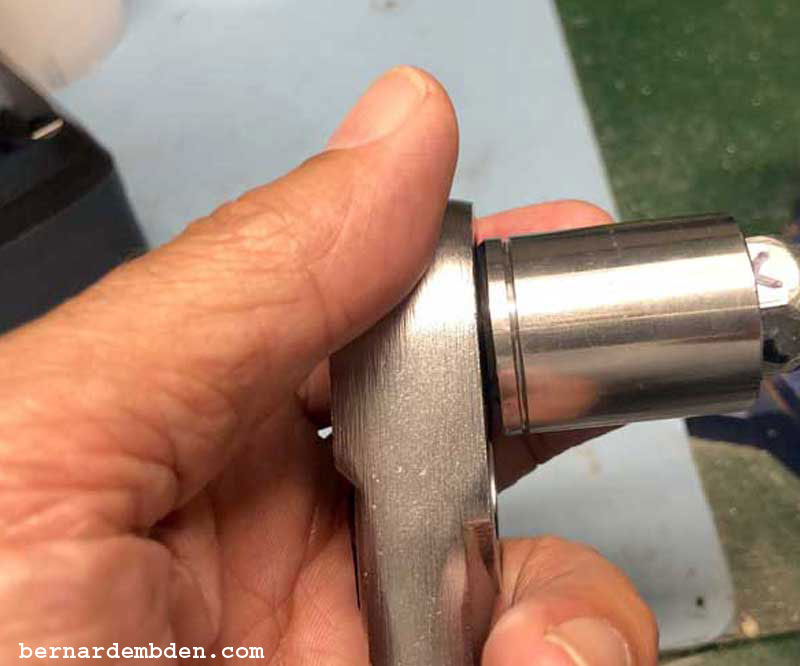
In the photograph below, force is applied to the handle of the wrench (yellow arrow). That force is converted to torque (turning force) at the screw (red arrow).
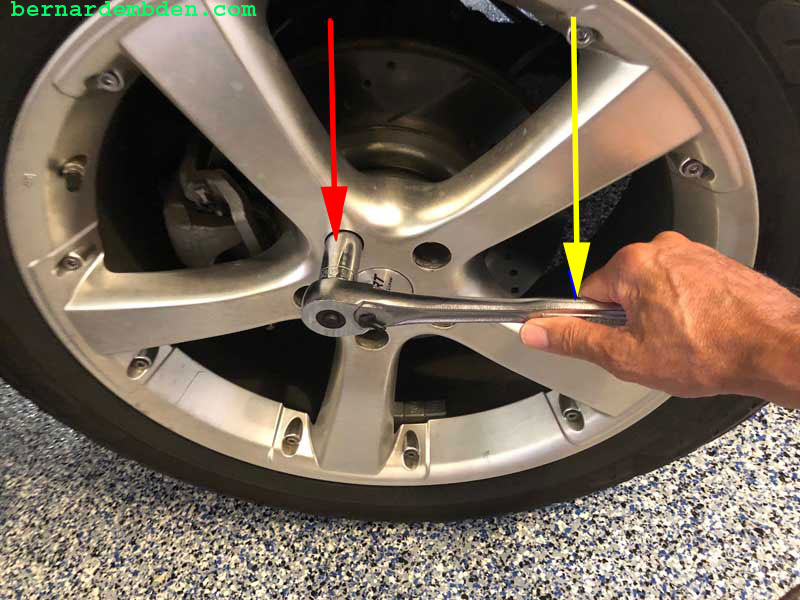
The woman is able to put 100 foot pounds of force against the wrench’s handle (yellow arrow) a generating 100 foot pound of turning torque at the screw (red arrow) and manages to turn the screw 50 percent of one revolution.
(This is a strong woman)
The man is able to put 100 foot pounds of torque against the wrench's handle and is also able to turn the screw the same 50 percent of one revolution.
The woman needs virtually no rest so she is able to again apply 100 foot pounds of torque to the wrench handle every 5 seconds.
The man is only able to exert 100 pounds of torque to the wrench handle once each 10 seconds, taking 20 seconds to complete one revolution of the screw.
The woman has the greater rate of work, so she will take 10 seconds to turn the screw one revolution. The 10 revolutions necessary is then accomplished in 100 seconds.
The man has the same torque, but it’s applied at a slower rate, so he takes 20 seconds to turn the screw one complete revolution. The 10 revolutions necessary is then accomplished in 200 seconds.
Horsepower is the rate of torque. Or as defined in physics as the RATE of doing work.
Note that they both had the same torque, but the woman had more horsepower.
How does this apply to an internal combustion engine?
Just about all modern automobile engines are four stroke designs.
Using a one cylinder engine as an example.
1) Intake stroke (Intake valve opens allowing a mixture of gas and air to be drawn into the combustion chamber as the piston moves to the bottom of its stroke.)
2) Compression stroke. (Intake valve closes, piston moves to the top position thus compressing the mixture of air and gas drawn in during the intake stroke.)
3) Power stroke (Sparkplug fires and ignites the compressed mixture of air and gas thus pushing the piston down).
4) Exhaust stroke (Exhaust valve opens, piston moves to top of its stroke thus pushing the exhaust gases (result of the compression stroke) out of the tailpipe.)
In a four stroke engine, the stroke cycle is completed once every two revolutions of the engine.
The only stroke that produces force is the power stroke. And it only produces force once every four strokes.
But, Torque by definition is, “a twisting force that may or may not cause a rotation”.
This is where the engine’s design comes in. The engine’s power stroke is converted to a twisting motion by the piston’s connecting rod connecting to the offset crankshaft journals. (See illustration below)
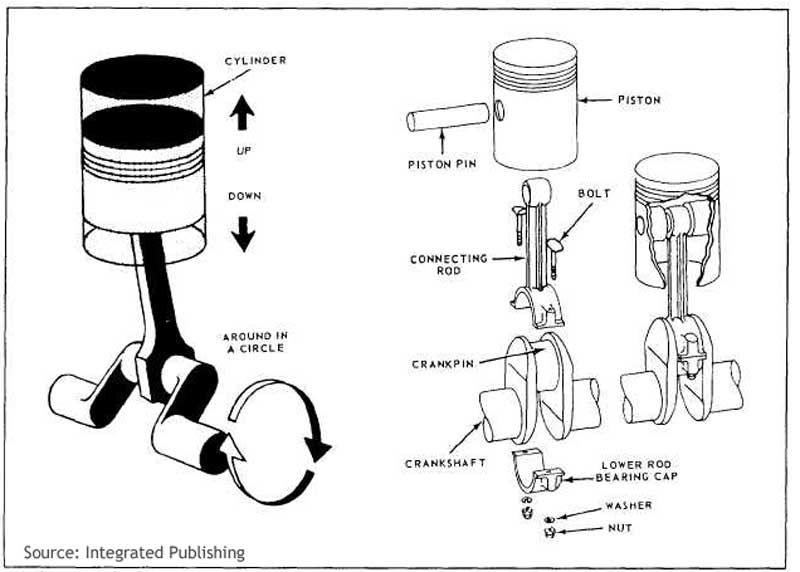
Unlike an electric motor, the internal combustion engine’s torque is not continuous. It’s momentary, once every four strokes of the engine. (That's part of the reason a four cylinder engine is not as smooth as a six cylinder engine).
Let’s theorize that our one cylinder engine has a bore of 4 inches and a stroke of 3 inches. And that the power stroke generates a force of 50 foot pounds on the piston to connecting rod to crankshaft journal, resulting in crankshaft rotation.
(For this example we will again forgo that formula that horsepower equals torque x RPM / 5252.
Fair Warning: Example below is for conceptual purposes only.
In the real world horsepower does not double when RPM does. (It’s a little more complicated.)
Let’s assume that at 1 RPM the engine develops 50 foot pounds of torque and 50 horsepower.
At 2 RPM the engine, with the same 50 foot pounds of torque, now develops 100 horsepower.
Essentially the work (torque) has not changed, however rate of work (RPM) has changed.
The old saying of “There is no replacement for displacement” is based on an engine’s displacement having a direct relationship to the amount of torque it generates.
If we increase the bore of the piston, or the length of the connecting rod, we increase the displacement of the engine. The larger the displacement, the more gas and air mixture is drawn into the combustion chamber, the bigger the sparkplug ignited explosion, the more powerful the power stroke, the greater the torque.
The greater the torque, the more horsepower the engine can produce as the rate of work is increased via increased RPM.
And a smaller engine, running at a greater RPM can have more horsepower than a larger engine (which produces more torque) running at a slower RPM.
While horsepower is important, the foundation for moving a car is torque. In the first example above, the woman is able to push the car to get it moving. If she did not have enough "force" (torque) to move the car then no amount of "horsepower" would get that car moving.
"Americans buy horsepower but drive on torque"
Which is better? More torque or more horsepower?
In 1953 Buick believed they had the answer.
It was more torque.
They developed and produced a V8 engine that completely emphasized torque over horsepower. They did this by designing an engine with small diameter intake runners and minimal timing advance. To maximize cylinder MEP, tiny intake and exhaust valves were used aligned in a vertical alignment in a narrow diameter head. Valve lift was emphasized and valve overlap was minimized. Because of the vertical alignment and small valve sizes, the engine is commonly referred to as the “Nailhead V8” engine.
The first generation Nailhead was made by Buick from 1953 to 1956. This engine displaced 264 CI and made only 143 HP. The Nailhead design generated maximum torque at about 2800 RPM. I believe the Nailhead engines all produced more torque than horsepower. The sacrifice was RPM. The design (primarily the tiny valves) limited RPM to about 4, 4000. This produced a viable street engine at the time.
(Nailhead engine photographed below. Note unusual valve covers parallel to the ground.)
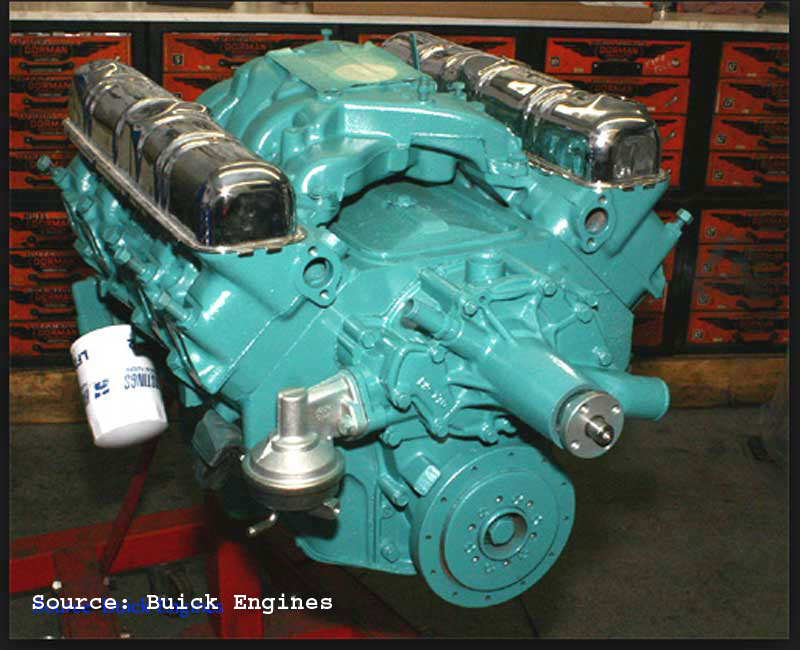
Cutaway of Nailhead showing unique intake and exhaust valves arrangement.
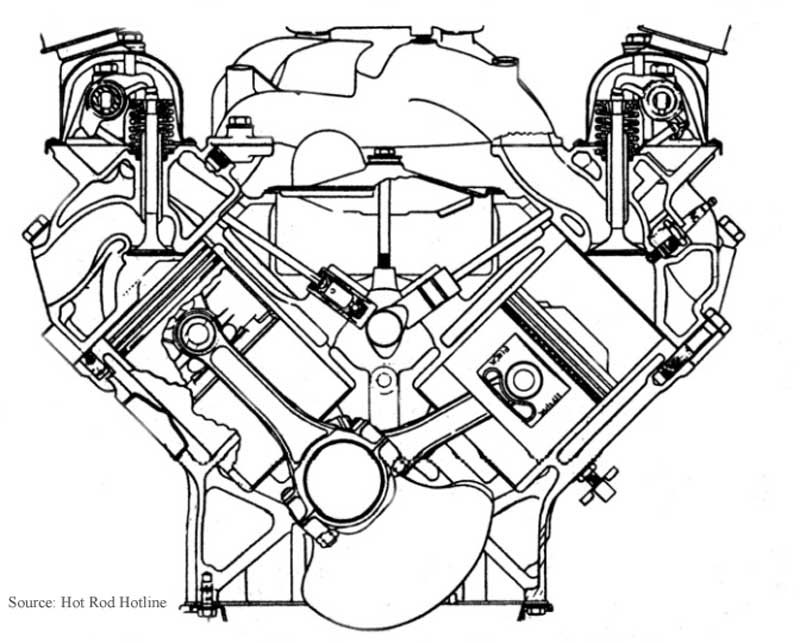
As cars needed more horsepower (and torque) the Nailhead engine's displacement was enlarged over the years. However, the deadly flaw of tiny valves caused these engines to “run out of breath” at 4000 to 4400 RPM.
As an example: The last version of the Nailhead V8 versus a current Honda 6 cylinder. At 60 MPG the Nailhead should be ahead of the Honda based on its massive torque advantage, however the Honda would probably be even at a 1/4 mile and definitely be ahead at the 1/2 mile mark.
The Nailhead design was finally abandoned, proving that the over reliance on torque had a fatal RPM limitation. Engines with less torque, but greater RPM capability ultimately produced faster automobiles. What was needed then was a sensible balance between both.
Let‘s examine two car manufacturers and their divulging engine design philosophies as they juggle the torque versus horsepower dilemma in creating engines for their Pony cars.
Ford and Chevrolet.
When the Ford Mustang came out in 1964 it was an immediate sales success. So much so that Chevrolet was forced to counter with their own version (the Camaro) in late 1966 as a 1967 model.They both offered V8 engines using overhead valves actuated via camshaft lobes and pushrods.
As the Pony car wars intensified, each manufacturer pushing the other to make better, more powerful cars, engine designs diverged.
In 1996 Ford went to a single overhead camshaft for the Mustang V8, followed in 2005 with an enhancement of 3 valves per cylinder with variable camshaft timing (VCT).
Chevrolet stuck with the "Small block Chevy engine" (SBC) and why not? It provided great low end torque, the single camshaft and pushrod design meant an efficient engine package, and it was cost effective. To gain torque and horsepower, they just kept making it larger.
For the 2011 Camaro, the displacement was increased to 6.2 liters and with improvements to its head and valve train it produced 426 HP at 5900 RPM with 420 foot pounds of torque.
In response Ford developed and put the 5 liter "Coyote" engine in the Mustang in 2011. This engine, unlike the SBC, was developed using the latest in engine technology. It was a double overhead camshaft design with 4 valves per cylinder, a hemispheric combustion chamber with the spark plug at the top of the chamber. It produced 412 HP at 6500 and 390 foot pounds of torque.
Note the differences in both engines that result in greater torque and horsepower for the Chevy SBC engine.
The SBC had a much larger displacement, 6.2 liters compared to the Ford’s 5.0 liter.
The SBC's larger displacement advantage produced an additional 30 foot pound of torque and 14 HP.
For such a huge difference in displacement, why were the differences in torque and horsepower not greater?
The answer? RPM. The SBC can only attain a maximum RPM of 5900. The Coyote? 6500.
Horsepower is the rate of torque. Or as defined in physics as the RATE of doing work.
The SBC has more torque (work), but the Ford engine has a greater rate of doing work, (RPM) so it almost equals the larger engine’s horsepower.
As these engines continued their developments, Ford upped the bar in 2015 by developing a flat plane crankshaft version of the Coyote engine code name "Voodoo" and put it into the Mustang GT 350. (You have got to love those names).
Without going into detail, all American V8 engines’ crankshafts were of the "cross plane" design. The "cross plane" V8 offers a smoother RPM because huge counter weights on the crankshaft minimize the primary vibration of the engine, while staggered cylinder firing minimizes secondary vibration.
The disadvantage of the cross plane design is that the necessary counter weights attached to the crankshaft adds unwanted rotational mass to the crankshaft, thus robbing the engine of power.
The advantage of the "flat plane" V8 design is that the huge counterweights on the crankshaft are not needed to suppress primary vibration. (The flat plane actually minimizes his primary vibration). Ford’s challenge was to manage the inherent vibration intrinsic in this design. Because it takes less power to spin the crankshaft, the flat plane will rev up much more quickly.
This Voodoo engine produced 526 HP and 428 food pounds of torque with a maximum RPM at the unheard of 8200 RPM.
Fast forward to present (2018) and the mighty battles between these two engines have only intensified. Now, however, their paths are more clearly defined.
The Chevrolet Camaro's engine puts more emphasis on displacement and torque.
Ford Mustang's engine puts more emphasis on RPM.
The 2018 Camaro engine (photograph below) is 6.2 liters rated at 455 HP at 6000 RPM with 455 foot pounds of torque at 4400 RPM. Note the engine design. It’s a pushrod design that has not fundamentally changed since its inception. Chevrolet has done an amazing job with keeping this engine relevant. Its small compact design and light weight has made it a favorite of the hot rod and car enthusiasts.
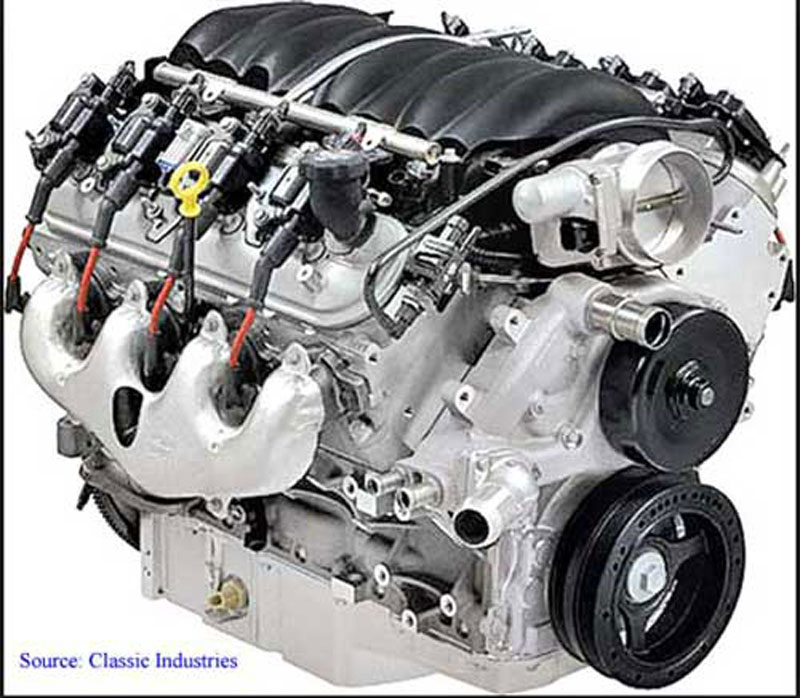
The 2018 Mustang "Coyote" engine (photographed below) is 5.2 liters rated at 460 HP at 7500 RPM and 420 foot pounds of torque at 4600 RPM. (Note that the torque is generated at a slightly higher RPM than the SBC.) The engine heads are significantly larger to house the 4 valve per cylinder and double overhead camshafts. Also note spark plug location as opposed to the SBC. Although a smaller engine, it’s able to match the torque and horsepower output of the larger SBC because of its superior RPM capabilities.
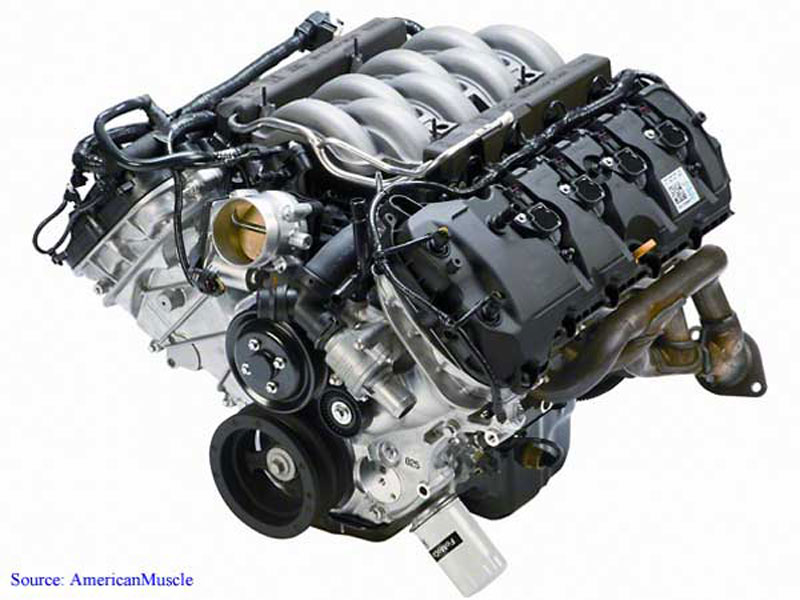
By slightly emphasizing (or de-emphasizing) torque, both manufacturers have developed amazing engines.
The future however, is with Ford.
The rumor is that the next variation of the Chevrolet Corvette will offer an option for a double overhead camshaft design engine. The reason? The SBC design produced terrific torque numbers, but the pushrod valve train and cylinder head two valve design will always limit RPM (and horsepower) when compared to 4 valve overhead cam engines. Chevrolet has taken this engine as far as it will go in powering their top end muscle and sport cars.
In a perfect world we would have large displacement engines creating high torque running at extremely high RPM generating massive horsepower. These engines would not weigh much and give 100 miles to a gallon of gas.
In reality engine design is a compromise, and the emphasis given to torque or horsepower is just one of those comprises. We need smaller engines for economics, weight reduction and handling. But we also need high torque and horsepower engines for our high performance cars. Changing engine material from iron to aluminum was a start. Smaller engines produce less torque, so engines were designed with greater RPM. Engines emissions and gas mileage requirements forced many manufacturers to pressurize their engines via supercharging and or turbocharging. Ferrari and Aston Martin, I believe the last two holdouts, have finally capitulated to turbocharging.
Pressuring an engine allows engine designers to design small engines that have significant torque AND horsepower while meeting current emissions and gas mileage requirements.
The pressuring of engines via supercharging or turbocharging has finally disproved the long held holy grail of “there is no replacement for displacement”.

